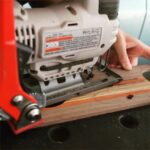Are you a woodworking enthusiast looking to protect your clothing from sawdust and splinters? In this comprehensive guide, we will show you how to make a woodworker’s apron that is not only functional but also customizable to fit your specific needs. From choosing the right material to adding pockets and tool holders, we’ve got you covered every step of the way.
Woodworking aprons are essential for any woodworker, providing protection and convenience during various projects. Whether you’re a professional or a hobbyist, having a durable and well-made apron can make all the difference in keeping yourself clean and organized while working on your latest creation.
In the following sections, we will walk you through the process of creating your very own woodworking apron. We’ll start with selecting the right material for your apron, then move on to measuring and cutting the fabric, sewing and assembling the apron, adding pockets and tool holders, personalizing your design, and providing tips for proper maintenance and care.
So grab your tools and let’s get started on making a woodworker’s apron that suits your individual style and needs.
Choosing the Right Material for Your Apron
When making a woodworker’s apron, choosing the right material is crucial for both functionality and comfort. The material you select will determine the durability of your apron and how well it can protect you from sawdust, wood chips, and other potential hazards in the workshop. Here are some factors to consider when choosing the right material for your woodworker’s apron:
1. Durability: Look for a sturdy and heavyweight fabric that can withstand the wear and tear of woodworking activities. Canvas or denim are popular choices for woodworking aprons due to their durability.
2. Comfort: Since you’ll be wearing the apron for extended periods, it’s important to choose a material that is comfortable against your skin. Consider options with a softer interior lining or breathable fabric to prevent overheating.
3. Protection: The material should provide adequate protection from dust, liquids, and sharp objects commonly found in woodworking environments. Water-resistant or waxed canvas can be a good option for added protection.
4. Easy to Clean: Woodworking can get messy, so choose a material that is easy to clean and maintain. Machine washable fabrics or those that can be wiped down easily are ideal for practicality.
When selecting the material for your woodworkers apron, consider these factors to ensure that you choose the best option for your needs.
By carefully selecting the right fabric for your woodworking apron, you can create a durable, comfortable, and protective garment that will enhance your woodworking experience.
For individuals who are looking forward on crafting their own woodworker’s apron at home just like me, here’s a basic guide on how to make one using sustainable materials which may also serve as an environmental-friendly choice as well.
Measuring and Cutting the Fabric
Accurate Measurements
Before you start cutting your fabric for your woodworkers apron, it’s crucial to take accurate measurements of your body. Measure around your waist and hips, as well as the desired length of the apron. Consider if you want a full-length apron or one that stops at the waist. Once you have these measurements, add seam allowances to ensure that the apron will fit comfortably.
Choosing the Right Fabric
When selecting the fabric for your woodworkers apron, it’s important to consider durability. Look for sturdy materials such as denim or canvas that can withstand wear and tear in a workshop environment. Additionally, consider choosing a fabric that is easy to clean and maintain, as woodworking can be a messy activity.
Cutting and Preparing the Fabric
Once you have measured and selected your fabric, carefully cut out the pieces for your apron according to your measurements. Be sure to mark where any straps or ties will be attached. It’s also a good idea to finish the edges of the fabric with a zigzag stitch or serger to prevent fraying before moving on to assembling and sewing your woodworkers apron.
By carefully measuring and cutting your fabric for a woodworkers apron, you’ll ensure that the end result fits comfortably and functions effectively in your woodworking activities.
Sewing and Assembling the Apron
Now that you have chosen the right material for your woodworkers apron, it’s time to start sewing and assembling it. Here are the steps for creating a functional and durable apron to protect your clothing while woodworking:
1. Cut the fabric: Once you have measured your body and determined the size of the apron, use those measurements to cut the fabric for the main body of the apron. Make sure to leave an extra inch around the edges for seams.
2. Sewing: Start by hemming the edges of the fabric to prevent fraying. Then, sew on straps or ties at the top of the apron so that you can fasten it around your neck and waist. You may also want to add adjustable straps for a comfortable fit.
3. Assembling: After sewing on the straps, carefully assemble any additional components, such as cross-back straps or waist ties, depending on your design preferences.
Remember to reinforce all seams with backstitching or double stitching to ensure that your apron can withstand daily wear and tear in your workshop.
By following these steps, you can create a custom woodworkers apron that meets your specific needs and preferences.
Adding Pockets and Tool Holders
Importance of Pockets and Tool Holders
Pockets and tool holders are essential features to consider when making a woodworker’s apron. These additional components provide convenient storage for small tools, screws, nails, pencils, measuring tape, and other items that are often necessary during woodworking projects.
Without pockets and tool holders, woodworkers may have to constantly search for these tools or carry them in their hands, which can be inconvenient and time-consuming. Therefore, adding pockets and tool holders to your DIY woodworkers apron can significantly improve efficiency and productivity in the workshop.
Designing Your Pockets and Tool Holders
When planning the layout of your apron’s pockets and tool holders, consider the types of tools you typically use during woodworking projects. Think about the sizes and shapes of these tools as well as how many pockets you will need to accommodate them.
Some popular options include large lower pockets for hand tools, smaller upper pockets for pencils or small rulers, loops for hammers or screwdrivers, and even special compartments for specific items such as a cell phone or a notepad. By customizing the design of your apron’s storage features based on your individual needs and preferences, you can ensure that your apron serves as a functional and practical accessory in your workshop.
Attaching Pockets and Tool Holders
Once you have determined the placement and design of your pockets and tool holders, it is time to attach them to your apron. Using strong sewing techniques such as double-stitching or reinforcing stress points with extra fabric will ensure that the pockets and tool holders are securely attached to the apron.
Be sure to test the durability of each pocket by placing tools inside them before completing any additional sewing or assembly. This step is crucial in ensuring that your DIY woodworker’s apron is both durable and reliable for holding all of your essential woodworking tools.
Personalizing Your Woodworkers Apron
When it comes to woodworking, having a personalized apron not only adds a touch of style but also enhances functionality. Personalizing your woodworkers apron can be as simple as adding your name or as detailed as incorporating unique design elements that reflect your individuality. Here are some creative ideas on how to personalize your woodworkers apron.
One popular way to personalize a woodworkers apron is by adding custom embroidery. This could include embroidering your name, initials, or even a logo onto the front of the apron. With the wide range of fonts and colors available, you can truly make it your own. Another option for personalization is to add patches or pins that showcase your interests or hobbies, making the apron not just a work accessory, but also a reflection of who you are.
For those with artistic flair, consider painting or dyeing the fabric of the apron to create a one-of-a-kind design. Use fabric paints or dyes in different colors and patterns to create a unique look that speaks to your personality. Additionally, you can attach leather accents or straps to the apron for a rugged and customized appearance.
An alternative approach is to use iron-on transfers or decals to add images or quotes that inspire you. These can easily be applied to the fabric and offer endless possibilities for personalizing your woodworkers apron.
Lastly, don’t forget about functionality and organization when personalizing your apron. Adding loops for holding tools, pockets for storing screws and nails, and compartments for other woodworking essentials can make the apron not only stylish but also extremely practical.
| Personalization Idea | Description |
|---|---|
| Custom Embroidery | Embroider name, initials, or logo onto the front of the apron |
| Painting/Dyeing Fabric | Create a one-of-a-kind design using fabric paints or dyes |
| Iron-On Transfers/Decals. | Add images or quotes that inspire you using iron-on transfers. |
Tips for Proper Maintenance and Care
Woodworking aprons are an essential piece of protective gear for anyone working with wood. Proper maintenance and care is crucial in ensuring the longevity of your apron and keeping it in good condition. Here are some tips for maintaining and caring for your woodworking apron.
One important tip for maintaining your woodworking apron is to regularly clean it after use. Depending on the type of work you do, your apron may collect sawdust, wood chips, or other debris that should be removed to prevent damage to the fabric. You can simply shake off excess debris and then hand wash or machine wash according to the care instructions for the fabric.
In addition to regular cleaning, it’s also important to inspect your woodworking apron for any signs of wear and tear. Look for frayed edges, loose stitches, or any areas where the fabric may be wearing thin. Repairing these issues promptly can prevent further damage and extend the life of your apron.
| Maintenance Tips | Details |
|---|---|
| Clean Regularly | Remove debris and hand or machine wash according to care instructions |
| Inspect for Wear and Tear | Check for frayed edges, loose stitches, thinning fabric, etc. |
Conclusion and Final Thoughts on DIY Woodworkers Aprons
In conclusion, crafting your own woodworkers apron can be a fulfilling and practical project for anyone with a passion for woodworking. By following the steps outlined in this article, you can create a custom apron that meets your specific needs and preferences. From choosing the right material to personalizing the design, every aspect of the apron can be tailored to enhance your woodworking experience.
One of the key takeaways from this guide is the importance of selecting the right material for your apron. Whether you prefer canvas, denim, or leather, the fabric you choose will significantly impact the durability and comfort of your apron. Additionally, taking accurate measurements and paying attention to detail during the cutting and sewing process will ensure a professional-looking result.
Adding pockets and tool holders to your woodworkers apron can greatly improve its functionality, providing convenient storage for essential tools and accessories. Furthermore, personalizing your apron with custom embroidery or patches can add a touch of individuality to your workwear. Finally, proper maintenance and care are essential for prolonging the lifespan of your apron, so remember to clean and store it appropriately after each use.
Overall, making your own woodworkers apron is a rewarding endeavor that allows you to create a practical and stylish accessory for all your woodworking projects. Whether you’re a seasoned craftsman or just starting out in woodworking, this DIY project offers an opportunity to showcase your skills and creativity while enhancing your work experience in the workshop.
Frequently Asked Questions
How Do You Make a Homemade Apron?
Making a homemade apron can be a fun and creative project. One common way to make a homemade apron is by using fabric, either new or repurposed from old clothes or linens. The fabric can be cut and sewn into the desired apron shape, with options to add pockets, straps, and other embellishments to personalize the design.
What Are the 5 Materials Needed for Making an Apron?
When making an apron at home, there are generally five main materials needed: fabric for the apron body, fabric for any additional features like pockets or trims, thread for sewing the pieces together, adjustable straps or ties for the neck and waist, and any decorative elements like buttons or patches if desired.
These materials can be easily found in most craft or fabric stores.
What Are Woodworking Aprons Made Of?
Woodworking aprons are typically made of durable materials that can withstand wear and tear from various tools and equipment. Heavy-duty canvas or denim are often used for woodworking aprons due to their strength and ability to protect against sharp objects or rough surfaces.
Additionally, leather is sometimes incorporated into woodworking aprons for added protection and durability. The construction of woodworking aprons focuses on functionality and resilience in order to provide adequate coverage and safeguarding during woodworking tasks.

Hi everyone! I’m a woodworker and blogger, and this is my woodworking blog. In my blog, I share tips and tricks for woodworkers of all skill levels, as well as project ideas that you can try yourself.





